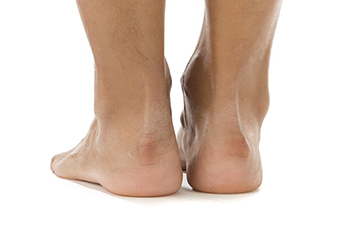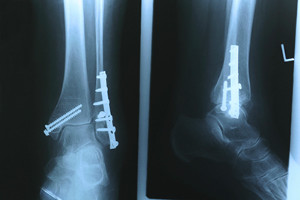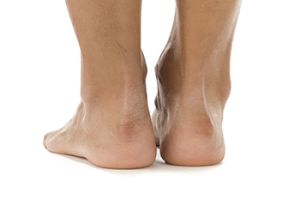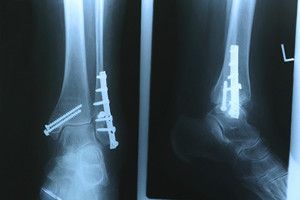
Toe Pain
Toe pain can originate from corns, calluses, hammertoes, and bunions, as well as ingrown toenails, sprains, fractures, and dislocations. Corns develop as the toe rubs against the inside of a shoe which causes the skin to thicken as a form of protection. A corn is typically cone-shaped and has a small, hardened spot that points inward. When a corn is pressed into the skin, the toe becomes painful. Corns usually form on the top or side of the toe. A callus is also a thickened patch of skin that generally forms on the bottom of the foot. Calluses are the result of friction from the toe rubbing against the inside of a shoe. They may also occur by walking barefoot or having flat feet. A hammertoe is a bump on the knuckle of the second toe that is produced by wearing shoes that are too short for your feet. The bony protrusion rubs against the top of the shoe causing pain and irritation. A bunion is a malformation of the big toe. The base of the big toe pushes away from the smaller toes, forcing the top of the big toe to press toward the other toes. Bunions can be hereditary, or they can result from injury to the toe joint or from wearing high heels with a narrow toe box. The toe becomes inflamed, and a bump may develop at the end of the misplaced bone. Ingrown toenails typically affect the big toe and its surrounding skin. The nail will dig into the skin and become painful. Wearing tight or narrow shoes that compress the big toe causes the nail to grow into the fleshy part of the toe. Cutting toenails incorrectly can also add to the development of an ingrown toenail. A toe sprain originates from a torn or stretched ligament. Strapping the injured toe to the toe next to it for stabilization is common. A broken or fractured toe usually occurs from trauma like dropping a heavy object on it or bumping into something extremely hard and rigid. Osteoporosis, a thinning of the bones, can also bring about toe fractures.
Any of the conditions mentioned can lead to pain and irritation. While some are more serious than others, seeking an examination and diagnosis from a podiatrist is a good idea. A podiatrist can treat each ailment and get you back on your feet again without pain.
Explaining Haglund’s Deformity

Haglund's deformity, commonly known as pump bump, is a bony enlargement that forms where the Achilles tendon attaches to the back of the heel bone. This painful condition often results from repetitive friction caused by wearing stiff or poorly fitting shoes, such as high heels or rigid-backed footwear. The constant rubbing leads to inflammation, redness, swelling, and the formation of calluses around the affected area. Those with abnormal foot mechanics, such as foot supination or high arches, are at higher risk of Haglund’s deformity. Symptoms include a visible bony bump, pain at the back of the heel, and swelling, particularly when wearing tight shoes. Conservative treatment includes reducing pressure and friction through wearing better-fitting footwear, heel pads, and certain exercises to alleviate pain and inflammation. In severe cases, surgery may be necessary to remove the bony protrusion and restore normal function. If you are experiencing persistent heel pain or suspect you have Haglund's deformity, it is suggested that you schedule an appointment with a podiatrist for an exam, a diagnosis and suggestions for treatment.
Many people suffer from bouts of heel pain. For more information, contact Dr. Scott Peters of Ankle & Foot Walk-In Clinic. Our doctor can provide the care you need to keep you pain-free and on your feet.
Causes of Heel Pain
Heel pain is often associated with plantar fasciitis. The plantar fascia is a band of tissues that extends along the bottom of the foot. A rip or tear in this ligament can cause inflammation of the tissue.
Achilles tendonitis is another cause of heel pain. Inflammation of the Achilles tendon will cause pain from fractures and muscle tearing. Lack of flexibility is also another symptom.
Heel spurs are another cause of pain. When the tissues of the plantar fascia undergo a great deal of stress, it can lead to ligament separation from the heel bone, causing heel spurs.
Why Might Heel Pain Occur?
- Wearing ill-fitting shoes
- Wearing non-supportive shoes
- Weight change
- Excessive running
Treatments
Heel pain should be treated as soon as possible for immediate results. Keeping your feet in a stress-free environment will help. If you suffer from Achilles tendonitis or plantar fasciitis, applying ice will reduce the swelling. Stretching before an exercise like running will help the muscles. Using all these tips will help make heel pain a condition of the past.
If you have any questions please contact our office located in Mayfield Village, OH . We offer the newest diagnostic and treatment technologies for all your foot and ankle needs.
Heel Pain
Have you ever gotten up from a chair or out of bed in the morning, and upon taking that first step, feel like your heel has stepped on a tack? Many people experience a feeling of sharp pain which radiates into their arch from their heel and which does not allow them to put their heel on the floor. Sometimes they need to sit back down, stand only on their toes and use the wall for balance. If you can take a few steps, it seems to go away and lessen, allowing you to then resume your activity. Later, throughout your day and after a period of rest, it can happen again. If this sounds familiar you may be suffering from your first attack of heel pain.
Heel pain is a debilitating condition that affects day to day activities. Running and walking both causes stress on the heel because the heel is the part of the foot that hits the ground first. This means that the heel is taking on your entire weight. Diagnosis and treatments for heel pain can be easily found through your podiatrist.
Plantar Fasciitis
One of the main causes of heel pain is a condition known as plantar fasciitis. The plantar fascia is a band of tissue that extends along the bottom of the foot, from the toe to the bottom of the heel. A rip or tear in this ligament can cause inflammation of these tissues, resulting in heel pain. People who do not wear proper fitting shoes are often at risk of developing problems such as plantar fasciitis. Unnecessary stress from ill-fitting shoes, weight change, excessive running, and wearing non-supportive shoes on hard surfaces are all causes of plantar fasciitis.
Achilles Tendonitis
Achilles tendonitis is another cause of heel pain. Similar to plantar fasciitis, inflammation of the Achilles tendon will cause heel pain due to stress fractures and muscle tearing. A lack of flexibility of the ankle and heel is an indicator of Achilles tendonitis. If left untreated, this condition can lead to plantar fasciitis and cause even more pain on your heel.
Heel Spur
A third cause of heel pain is a heel spur. A heel spur occurs when the tissues of the plantar fascia undergo a great deal of stress, leading to a separation of the ligament from the heel bone entirely. This results in a pointed fragment of bone on the ball of the foot, known as a heel spur.
How an Ankle Fracture Can Disrupt Life
 A fractured ankle can significantly disrupt daily life, particularly impacting employment. This type of injury often requires an extended period of immobilization, followed by a lengthy rehabilitation process to restore full functionality. The inability to walk or stand for prolonged periods can make it challenging to perform job duties, especially in physically demanding roles. Consequently, high rates of unemployment and disability are observed among those with severe ankle fractures. The disruption stems from the need for rest and restricted movement to ensure proper healing, which can lead to extended absences from work. Additionally, the pain and swelling associated with a fractured ankle can hinder mobility and productivity. Without adequate treatment and rehabilitation, complications such as chronic pain, instability, and arthritis may develop, further delaying recovery and complicating return-to-work plans. If you have suffered an ankle fracture, it is strongly suggested that you receive a comprehensive treatment plan from a podiatrist to recover efficiently and return to work as quickly as possible.
A fractured ankle can significantly disrupt daily life, particularly impacting employment. This type of injury often requires an extended period of immobilization, followed by a lengthy rehabilitation process to restore full functionality. The inability to walk or stand for prolonged periods can make it challenging to perform job duties, especially in physically demanding roles. Consequently, high rates of unemployment and disability are observed among those with severe ankle fractures. The disruption stems from the need for rest and restricted movement to ensure proper healing, which can lead to extended absences from work. Additionally, the pain and swelling associated with a fractured ankle can hinder mobility and productivity. Without adequate treatment and rehabilitation, complications such as chronic pain, instability, and arthritis may develop, further delaying recovery and complicating return-to-work plans. If you have suffered an ankle fracture, it is strongly suggested that you receive a comprehensive treatment plan from a podiatrist to recover efficiently and return to work as quickly as possible.
Broken ankles need immediate treatment. If you are seeking treatment, contact Dr. Scott Peters from Ankle & Foot Walk-In Clinic. Our doctor can provide the care you need to keep you pain-free and on your feet.
Broken Ankles
A broken ankle is experienced when a person fractures their tibia or fibula in the lower leg and ankle area. Both of these bones are attached at the bottom of the leg and combine to form what we know to be our ankle.
When a physician is referring to a break of the ankle, he or she is usually referring to a break in the area where the tibia and fibula are joined to create our ankle joint. Ankles are more prone to fractures because the ankle is an area that suffers a lot of pressure and stress. There are some obvious signs when a person experiences a fractured ankle, and the following symptoms may be present.
Symptoms of a Fractured Ankle
- Excessive pain when the area is touched or when any pressure is placed on the ankle
- Swelling around the area
- Bruising of the area
- Area appears to be deformed
If you suspect an ankle fracture, it is recommended to seek treatment as soon as possible. The sooner you have your podiatrist diagnose the fracture, the quicker you’ll be on the way towards recovery.
If you have any questions, please feel free to contact our office located in Mayfield Village, OH . We offer the newest diagnostic and treatment technologies for all your foot care needs.
All About Broken Ankles
Broken ankles are a serious injury that can lead to an inability to walk, function, and also cause a significant amount of pain. A broken ankle is a break in one of the three bones in your body that connect at the ankle joint: the tibia, the fibula, and the talus. The tibia and fibula are your two primary leg bones that connect at the knee, which sit directly upon the talus bone. This is protected by a fibrous membrane that allows for movement in the ankle joint. A broken ankle is usually caused by the foot rolling under or twisting too far, causing one of these three bones to snap.
A broken ankle is different from an ankle sprain, which occurs when the ankle ligaments are ripped or torn but no bones have been broken. A sprain can still be very severe, causing bruising in the foot and an inability to hold your own weight, much like a broken ankle would. If you’re unable to stand, and suspect that you have a broken ankle, the first thing to do would be to get an immediate X-ray to determine the severity of the break.
A common cause of broken ankles is when the ankle is rolled over with enough pressure to break the bones. This usually happens during exercise, sports, or other physical activity. Another common cause is a fall or jump from a tall height.
One immediate treatment for pain relief is elevating the foot above your head to reduce blood flow to the injured area. You can also apply ice packs to your ankle to help reduce swelling, redness, inflammation, and pain. After these initial steps, getting a cast and staying off your feet as much as possible will aid in the recovery of the broken ankle. The less movement and stress the ankle has to endure, the more complete it will heal. A doctor can determine if surgery is needed in order to heal correctly. In these cases, an operation may be the only option to ensure the ability to walk properly again, followed by physical therapy and rehabilitation.
It is highly important to determine if surgery is needed early on, because a broken ankle can become much more severe than you realize. If not professionally treated, the broken ankle will inhibit your walking, daily functioning, and produce a large amount of pain. Treating your broken ankle early on will help prevent further damage to it.
Lower Limb and Foot Injuries in Athletic Children
 Lower limb and foot injuries are common in athletic children, partly due to the vulnerability of their growth plates. Growth plates are the developing areas of cartilage at the end of the long bones in the legs where bone growth takes place. These plates are weaker than nearby tendons and ligaments, making them more susceptible to injury. This is especially true when under the stress of repetitive physical activities in sports. Movements like running, jumping, and quick pivoting can place excessive strain on growth plates, leading to conditions such as Sever's disease, or heel pain. Ankle sprains are also common because ligaments in children tend to be more elastic than in adults. The biomechanics of growing children, such as variations in gait, muscle strength, and coordination during growth spurts, can further predispose them to these injuries as their bodies adapt to rapid physical changes. A podiatrist, or foot doctor, can treat these types of injuries common in active children. They may suggest treatments ranging from rest and elevation to custom orthotics that support proper alignment and reduce stress on the growth plates. Treatments vary depending on the injury. If your child is struggling with a lower limb or foot injury, it is suggested you consult with a podiatrist for targeted care.
Lower limb and foot injuries are common in athletic children, partly due to the vulnerability of their growth plates. Growth plates are the developing areas of cartilage at the end of the long bones in the legs where bone growth takes place. These plates are weaker than nearby tendons and ligaments, making them more susceptible to injury. This is especially true when under the stress of repetitive physical activities in sports. Movements like running, jumping, and quick pivoting can place excessive strain on growth plates, leading to conditions such as Sever's disease, or heel pain. Ankle sprains are also common because ligaments in children tend to be more elastic than in adults. The biomechanics of growing children, such as variations in gait, muscle strength, and coordination during growth spurts, can further predispose them to these injuries as their bodies adapt to rapid physical changes. A podiatrist, or foot doctor, can treat these types of injuries common in active children. They may suggest treatments ranging from rest and elevation to custom orthotics that support proper alignment and reduce stress on the growth plates. Treatments vary depending on the injury. If your child is struggling with a lower limb or foot injury, it is suggested you consult with a podiatrist for targeted care.
The health of a child’s feet is vital to their overall well-being. If you have any questions regarding foot health, contact Dr. Scott Peters of Ankle & Foot Walk-In Clinic. Our doctor can provide the care you need to keep you pain-free and on your feet.
Tips for Keeping Children's Feet Healthy
- Make sure their shoes fit properly
- Look for any signs of in-toeing or out-toeing
- Check to see if they have Clubfoot (condition that affects your child’s foot and ankle, twisting the heel and toes inward) which is one of the most common nonmajor birth defects.
- Lightly cover your baby’s feet (Tight covers may keep your baby from moving their feet freely, and could prevent normal development)
- Allow your toddler to go shoeless (Shoes can be restricting for a young child’s foot)
- Cut toenails straight across to avoid ingrown toenails
- Keep your child’s foot clean and dry
- Cover cuts and scrapes. Wash any scratches with soap and water and cover them with a bandage until they’ve healed.
If you have any questions, please feel free to contact our office located in Mayfield Village, OH . We offer the newest diagnostic and treatment technologies for all your foot care needs.
How to Care for Your Child's Feet
It is never normal for a child to experience pain in his or her feet. Foot pain that lasts more than a few days and limits a child’s ability to walk should be examined by a podiatrist. Many adult foot ailments originate in childhood and may be present at birth. Common foot issues that are experienced by children are pediatric flat foot, Sever’s disease, ingrown toenails, and plantar warts.
A child’s foot grows rapidly during the first year, allowing it to reach almost half of their adult foot size. Consequently, foot specialists consider the first year to be the most crucial point in the foot development process. There are ways you can help ensure that your child’s foot develops properly. One way is to carefully look at your baby’s feet. If you notice any deformities, you should immediately seek professional care. You should also loosely cover your child’s foot, since tight coverings may prevent movement and inhibit normal development. Another tip is to change the baby’s positioning throughout the day. If your baby lies down in one spot for too long, it may put an excess amount of strain on the feet and legs.
It is best that you try not to force a child to start walking. Children will begin to walk when they are both physically and emotionally capable to do so. You should also avoid comparing your child’s walking progress with other children because the age range for independent walking may range. When your child’s feet begin to develop, you may need to change both their shoe and sock size every few months to allow room for their feet to grow.
Kids are sometimes prone to splinters, cuts, and severe injuries because they tend to walk around barefoot. This also makes them more susceptible to developing plantar warts which is a condition caused by a virus that invades the sole of the foot through breaks in the skin. These ailments can be avoided by making sure your child wears shoes in unsanitary environments. You should also wash any minor cuts or scrapes on your child’s feet. It is a myth that exposure to fresh air will heal injuries; fresh air will only expose your child’s cuts to germs.
As a parent, you should ensure that your child’s feet are developing properly and are being properly maintained. Consequently, it is important that you perform routine inspections on his or her feet to detect any injuries or deformities in their early stages. Early detection and treatment will help to ensure that your child does not develop any serious foot conditions.
Definition and Success Rates of Plantar Fasciitis Surgery

Plantar fasciitis surgery is a treatment option for individuals who have not found relief from conservative measures and continue to experience severe and debilitating heel pain. The surgery typically involves releasing or removing a portion of the plantar fascia to alleviate tension and reduce inflammation. This procedure aims to provide long-term pain relief and restore normal foot function. Success rates of plantar fasciitis surgery vary depending on various factors, such as the patient's overall health, the severity of the condition, and the specific surgical technique used. While many patients experience significant improvement in symptoms and quality of life following surgery, it is essential to understand that success is not guaranteed, and there are risks associated with any surgical procedure. If you have this condition and are considering surgery, it is strongly suggested that you speak with your podiatrist who can guide you toward making an informed decision.
Foot surgery is sometimes necessary to treat a foot ailment. To learn more, contact Dr. Scott Peters of Ankle & Foot Walk-In Clinic. Our doctor will assist you with all of your foot and ankle needs.
When Is Surgery Necessary?
Foot and ankle surgery is generally reserved for cases in which less invasive, conservative procedures have failed to alleviate the problem. Some of the cases in which surgery may be necessary include:
- Removing foot deformities like bunions and bone spurs
- Severe arthritis that has caused bone issues
- Cosmetic reconstruction
What Types of Surgery Are There?
The type of surgery you receive will depend on the nature of the problem you have. Some of the possible surgeries include:
- Bunionectomy for painful bunions
- Surgical fusion for realignment of bones
- Neuropathy decompression surgery to treat nerve damage
Benefits of Surgery
Although surgery is usually a last resort, it can provide more complete pain relief compared to non-surgical methods and may allow you to finally resume full activity.
Surgical techniques have also become increasingly sophisticated. Techniques like endoscopic surgery allow for smaller incisions and faster recovery times.
If you have any questions please feel free to contact our office located in Mayfield Village, OH . We offer the newest diagnostic and treatment technologies for all your foot and ankle needs.
Foot Surgery
In most cases, foot surgery is often chosen as the last available option for conditions that have otherwise been unsuccessfully treated. Surgery may be necessary for several reasons, including the removal of foot deformities (e.g. bone spurs or bunions), arthritis problems, reconstruction due to injury, and congenital malformations (e.g. club foot or flat feet). Regardless of one’s age, foot surgery may be the only successful option for treatment for certain conditions.
The type of surgery one undergoes depends on the type of foot condition the patient has. For the removal of a bunion growth, a bunionectomy is necessary. If the bones in the feet need to be realigned or fused together, a surgical fusion of the foot is needed. For pain or nerve issues, a patient may require surgery in which the tissues surrounding the painful nerve are removed. Initially, less invasive treatments are generally attempted; surgery is often the last measure taken if other treatments are unsuccessful.
While in many cases surgery is often deemed as the final resort, choosing surgery comes with certain benefits. The associated pain experienced in relation to the particular condition is often relieved with surgery, allowing patients to quickly resume daily activities. The greatest benefit, however, is that surgery generally eliminates the problem immediately.
Podiatry history has shown that foot treatments continue to evolve over time. In the field of foot surgery, endoscopic surgery is just one of the many advanced forms of surgery. As technology vastly improves so too will the various techniques in foot surgery, which already require smaller and smaller incisions with the use of better and more efficient tools. Thanks to such innovations, surgery is no longer as invasive as it was in the past, allowing for faster and easier recoveries.






